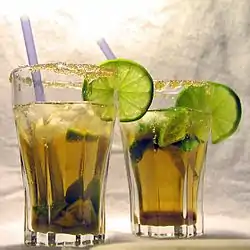 | |
| Country of origin | Germany |
|---|---|
| Introduced | 1924 |
| Website | www |
Club-Mate (German pronunciation: [ˈklʊp ˈmaːtə]) is a caffeinated carbonated mate-extract beverage made by the Loscher Brewery (Brauerei Loscher) near Münchsteinach, Germany, which originated in 1924.[1] Club-Mate has 20 mg of caffeine per 100 ml, sugar content of 5 g per 100 ml, and 20 kcal per 100 ml, which is lower than other beverages such as cola or most energy drinks.
Club-Mate is available in 0.33-litre and 0.5-litre bottles.
Some Club-Mate bottles include the slogan "man gewöhnt sich daran", which roughly translates into a challenge to the drinker of "one gets used to it".
Examples of Club-Mate-based mixed drinks are: vodka-mate; Tschunk,[2][3] a combination of rum and Club-Mate; Jaeger-Mate, a mix of Jägermeister and Club-Mate.
History
Geola Beverages of Dietenhofen, Germany originally formulated and marketed Club-Mate under the name Sekt-Bronte in 1924.[4] The drink was only known regionally until acquired by Loscher and marketed under the name Club-Mate in 1994.[5]
In December 2007, Loscher marketed a Club-Mate winter edition. The limited-edition Club-Mate consists of the original formula mixed with cardamom, cinnamon, star anise and citrus extract. It is since sold regularly for a limited time during winter.
In 2009, a Club-Mate-styled cola variety was introduced. Unlike other colas, its recipe includes mate-extract.
In 2013, Club-Mate Granat, a Club-Mate variety with additional pomegranate flavor, was introduced.
Club-Mate Zero, a sugar free version of Club-Mate is available since April 2022.[6]
As of July 2010, the company listed countries for example the United Kingdom,[7] the United States,[8] Belgium,[9] Bulgaria [10] and Luxembourg to reach distributors in 60 countries,[11] primarily in Europe, but also in Canada,[12] Australia, Hong Kong, Costa Rica and Taiwan.[13]
Hacker culture
Club-Mate has developed a following in computer hacker culture and tech start-ups, especially in Europe. Bruce Sterling wrote in Wired magazine that it is the favorite beverage of Germany's Chaos Computer Club.[14] It is also popular at Noisebridge[15] and HOPE[16] in the United States, Electromagnetic Field in the UK, the Hack-Tic events in the Netherlands and the FOSDEM in Belgium. Club-Mate appeared in numerous leading media websites like Al-Jazeera,[17] TechCrunch[18] and Vice.[19]
Ingredients and variations
- Water
- Inverted sugar syrup
- Sugar
- Mate tea extract
- Citric acid
- Caffeine
- Natural flavors
- Caramel color
- Carbonic acid
There are several variations on the original recipe available: Club-Mate IceT Kraftstoff (an iced-tea variant with slightly higher caffeine content (220 mg per L) and more sugar), Club-Mate Granat (with added pomegranate for a more fruity taste) and Club-Mate Winter Edition (with spices giving it a gingerbread-like taste - this edition is only available during the winter months).[6] The latest variation is Club-Mate Zero, a sugar free version.[6]
Tschunk
| Cocktail | |
|---|---|
 | |
| Type | Highball |
| Base spirit | |
| Commonly used ingredients |
|
| Preparation | Dice limes, put them together with the brown sugar into a high glass and crush both. Add crushed ice and pour the rum and the Club-Mate over it. Add a straw |
Tschunk [ˈtʃʊnk] is a German highball consisting of Club-Mate and white or brown rum. It is usually served with limes and cane or brown sugar.[20][21]
Like Club-Mate, the Tschunk is a typical drink within European hacker culture[22][23] and can often be found at scene typical events or locations like the Chaos Communication Congress.[21][24]
See also
- Materva, a Cuban carbonated mate-based beverage
Notes and references
- ↑ "Club Mate Reviews, Photos, Information, Videos and TV Ads". dizzyfrinks.com. Archived from the original on 2014-12-14. Retrieved 2011-11-14.
- ↑ "Tschunk – Entropia". entropia.de.
- ↑ "Tschunk Cocktail Recipe". 6 April 2021.
- ↑ "WaaAAAAAACH!!Als Sekt-Bronte begonnen, als Einhornpisse geendet". Die Tageszeitung: Taz. 27 December 2011. p. 13.
- ↑ "Goldgrüne Flüssigkeit zum Saugen". Der Tagesspiegel Online. 16 January 2006.
- 1 2 3 "Produkte – CLUB-MATE".
- ↑ "Club-Mate-UK". Retrieved 2010-11-01.
- ↑ "Club-Mate USA". Archived from the original on 2021-12-27. Retrieved 2014-12-30.
- ↑ "clubmate.be - Domain Name For Sale". Dan.com.
- ↑ "Club-Mate Bulgaria". Facebook.
- ↑ "Manufacturer – Club-Mate / The Icetea". clubmate.de.
- ↑ "Club-Mate Canada". Facebook.
- ↑ "International – CLUB-MATE".
- ↑ Bruce Sterling (2007-04-01). "Club-Mate, favorite drink of the Chaos Computer Club". Wired.
- ↑ "Club Mate - Noisebridge". noisebridge.net.
- ↑ "Club-Mate". 2600 Magazine. Archived from the original on 2015-08-15. Retrieved 2009-11-12.
- ↑ Stupp, Catherine. "German hackers' drink of choice". www.aljazeera.com.
- ↑ "Flying high on Club Mate – TechCrunch". techcrunch.com. 11 February 2010.
- ↑ "How a German Soda Became Hackers' Fuel of Choice | Motherboard". motherboard.vice.com. Archived from the original on 2014-03-02.
- ↑ "Tschunk – Hacker's Cocktail with Club Mate". 20 December 2020.
- 1 2 Silver, Vernon (27 June 2017). "The Chaos Computer Club Is Fighting to Save Democracy". Bloomberg L.P. Retrieved 14 July 2017.
- ↑ "Club-Mate: The Favorite Drink of German Hackers and Club Kids Is Here". Eater.com. Vox Media. 8 September 2015. Retrieved 3 April 2018.
- ↑ "Hacking Club-Mate". Make. 24 May 2011.
- ↑ Judith Horchert (28 December 2013). "Chaospatinnen: Betreuung für den ersten Besuch beim Hackerkongress". Spiegel Online (in German).
External links
- Home Page for Club-Mate
- "History of Loscher Brewery. Includes information on acquisition of Geola Beverages" (in German). Archived from the original on 2007-10-11. Retrieved 2008-05-23.